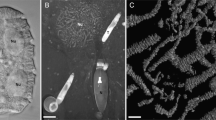Summary
Cytomorphic structure was studied in erythrocytes ofBatrachoseps salamanders, a genus unique among non-mammalian vertebrates because most of the erythrocytes are anucleate. These anucleate erythrocytes are highly flattened, quite variable in size, and generally elliptical. All of them were found to contain marginal bands of microtubules (MBs), as observed in phase contrast and darkfield after Triton lysis. The MBs of larger cells typically twisted into figure-8 forms upon lysis. Whole mounts of the lysed anucleate cells consisted only of the MB plus a trans-MB network of material (TBM), as observed by electron microscopy. If lysis was carried out in the presence of 0.5 M KCl, all of the MBs circularized immediately and none were twisted. The network (TBM) was now missing, suggesting that it is needed for maintenance of MB ellipticity and plays a role in MB twisting. Small numbers of living anucleate erythrocytes were constricted in their mid-region, and others were pointed at one end. Correspondingly pointed MBs were observed after lysis, exhibiting a range of forms compatible with the mechanism proposed byEmmel (1924) in which the anucleate erythrocytes arise by amitotic division of nucleated ones.
The results show that these erythrocytes retain the typical nonmammalian cytomorphic system, and are thus unlike those of adult mammals. The network component (TBM) is present even though nuclei are absent, making it unlikely that it functions simply to position the nucleus. The observations are consistent with the hypothesis that the flattened, elliptical shape of non-mammalian vertebrate erythrocytes is generated by TBM tension applied across the faces of the MB “frame”, and that excessive tension induced by lysis (without KCl) produces MB twisting.
Similar content being viewed by others
References
Andrew, W., 1965: Comparative Hematology. New York, N.Y. Grune and Stratton.
Barclay, N. E., 1966: Marginal bands in duck and camel erythrocytes. Anat. Rec.154, 313.
Bertolini, B., Monaco, G., 1976: The microtubule marginal band of the newt erythrocyte. Observations on the isolated band. J. Ultrastruct. Res.54, 57–67.
Blanchet, J. P., 1974: Chicken erythrocyte membranes: comparison of nuclear and plasma membranes from adults and embryos. Exp. Cell Res.84, 159–166.
Cavanaugh, G. M., Ed., 1975: Formulae and Methods VI of the Marine Biological Laboratory Chemical Room. Woods Hole, Mass.: The Marine Biological Laboratory.
Chan, L. L., 1977: Changes in the composition of plasma membrane proteins during differentiation of embryonic chick erythroid cell. P. N. A. S. USA74, 1062–1066.
Cohen, W. D., 1978 a: Observations on the marginal band system of nucleated erythrocytes. J. Cell Biol.78, 260–273.
—, 1978 b: Lability of the marginal band systemin vitro. J. Cell Biol.79, 309 a.
—,Bartelt, D. C., Jaeger, R., Langford, G., Nemhauser, I., 1982: The cytoskeletal system of nucleated erythrocytes. I. Composition and function of major elements. J. Cell Biol.93, 828–838.
—,Nemhauser, I., Jaeger, R. F., 1977: Rapid visualization of the marginal band system in blood cells of marine species. Biol. Bull.153, 420.
— —,Cohen, M. F., 1978: Marginal bands ofHomarus americanus coelomocytes: disappearance associated with changes in cell morphology. Biol. Bull.155, 431–432.
—,Terwilliger, N. B., 1979: Marginal bands in camel erythrocytes. J. Cell Sci.36, 97–107.
Emmel, V. E., 1921: Hematological and respiratory conditions in the larval stages of the lungless amphibians. Anat. Rec.21, 56.
—, 1924: Studies on the non-nucleated elements of the blood. Am. J. Anat.33, 347–391.
Fairbanks, G., Steck, T. L., Wallach, D. F. H., 1971: Electrophoretic analysis of the major polypeptides of the human erythrocyte membrane. Biochemistry10(13), 2606–2617.
Fischer, T. M., 1978: A comparison of the flow behavior of disc shaped versus elliptic red blood cells. Blood cells4, 453–461.
Goniakowska-Witalinska, L., Witalinski, W., 1977: Occurrence of microtubules during erythropoiesis inLlama glama. J. Zool. (Lond.)181, 309–313.
Hansen, V. K., Wingstrand, K. G., 1960: Further studies on the non-nucleated erythrocytes ofMaurolicus mulleri, and comparisons with the red blood cells of related fishes. Dana Rep. No.54, 1–15.
Jackson, R. C., 1975: The exterior surface of the chicken erythrocyte. J. biol. Chem.250, 617–622.
Kirkpatrick, F. H., 1976: Spectrin: current understanding of its physical, biochemical, and functional properties. Life Sci.19, 1–18.
Lacelle, P. L., Evans, E. A., Hochmuth, R. M., 1977: Erythrocyte membrane elasticity, fragmentation, and lysis. Blood Cells3, 335–350.
Lux, S. E., John, K. M., Karnovski, M. J., 1976: Irreversible deformation of the spectrin-actin lattice in irreversibly sickled cells. J. Clin. Invest.51, 1790–1797.
Ralston, G. B., 1975: Proteins of the camel erythrocyte membrane. Biochim. biophys. Acta401, 83–94.
Rebhun, L. I., Rosenbaum, J., Lefebre, P., Smith, G., 1974: Reversible restoration of the birefringence of cold-treated isolated mitotic apparatus of surf clam eggs with chick brain tubulin. Nature (Lond.)249, 113–115.
Schmid-Schönbein, H., 1975: Erythrocyte rheology and the optimization of mass transport in the microcirculation. Blood cells1, 285–301.
Stebbins, R. C., 1966: A Field Guide to Western Reptiles and Amphibians. Boston: Houghton Mifflin Co.
Steck, T. L., 1974: The organization of proteins in the human red blood cell membrane. J. Cell Biol.62, 1–19.
Tilney, L. G., Detmers, P., 1975: Actin in erythrocyte ghosts and its association with spectrin. J. Cell Biol.66. 508–520.
Van Deurs, B., Behnke, O., 1965: The microtubule marginal band of mammalian red blood cells. Z. Anat. Entwickl.-Gesch.143, 43–47.
Weisenberg, R. C., 1972: Microtubule formationin vitro in solutions containing low calcium concentrations. Science (Wash., D.C.)177, 1104–1105.
Wingstrand, K. G., 1956: Non-nucleated erythrocytes in a teleostean fishMaurolicus mulleri. Z. Zellforsch.45, 195–200.
Author information
Authors and Affiliations
Rights and permissions
About this article
Cite this article
Cohen, W.D. The cytomorphic system of anucleate non-mammalian erythrocytes. Protoplasma 113, 23–32 (1982). https://doi.org/10.1007/BF01283036
Received:
Accepted:
Issue Date:
DOI: https://doi.org/10.1007/BF01283036




